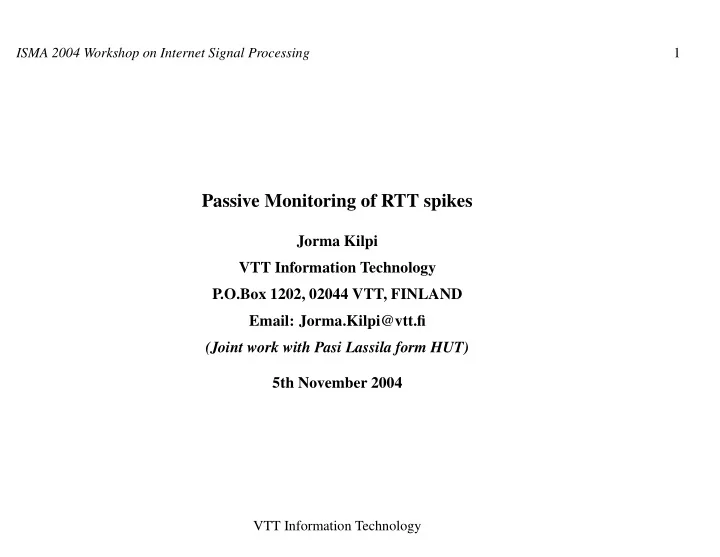

ISMA 2004 Workshop on Internet Signal Processing 1 Passive Monitoring of RTT spikes Jorma Kilpi VTT Information Technology P.O.Box 1202, 02044 VTT, FINLAND Email: Jorma.Kilpi@vtt.fi (Joint work with Pasi Lassila form HUT) 5th November 2004 VTT Information Technology
� � � � ISMA 2004 Workshop on Internet Signal Processing 2 Problem formulation: Sudden increase in the RTT of a TCP/IP connection is called an RTT spike . – Such a phenomenom may exist specially in mobile/wireless environments. – Spikes are not congestion related but, instead, are unpredictable for the TCP . – In mobile connections mobility management and mobile routing are possible sources of such spikes. – In wireless connections the distance to the base station is one possible source of spikes. In the worst case the RTT estimation algorithm of TCP gets confused, spurious timeouts and unnecessary retransmissions cause loss of goodput for TCP. (A Strict RTT spike.) Even without a retransmission the goodput of TCP gets worse. (A [non-strict] RTT spike.) What is the statistical significance of this phenomenom and how to monitor it passively? Statistical inference and modeling? VTT Information Technology
� � � � ✆ ☎ � ✁ ✁ ✂ ✄ ✁ ✁ ✁ ☎ ✄ ✁ � ✁ ✁ ✂ ✆ ✁ � � ✁ ✂ ✄ � ISMA 2004 Workshop on Internet Signal Processing 3 Available measurements: (In GSM/GPRS, EDGE/GPRS) There are four different ’half’ RTT ����������� ����������� �������� ���� �������� ���� cases: ����� �������� �������� ������ ������ ����� �������� �������� �������� �������� ������� ������� ������� End host Mobile Internet Client All down- and upstream traffic of Server a TCP flow goes through the same GGSN. Time difference of a data segment We concentrate for . and the corresponding ACK, meas- ured at GGSN is called ’half’ RTT. VTT Information Technology
✗ ✍ ✩ ✑ ✏ ✍ ✎ ✁ ✌ ✖ ☞ ✠ ☛ ✡ ✠ ✠ ✕ ✤ ✆ � ✓ ✄ ✣ ✄ ★ � ✗ ✎ ✘ ✖ ✕ ✚ ✙ ✘ ✆ ✂ � ✞ ☎ ☎ � ✹ ✝ ✩ ✺ ✪ ✲✳✴✵ ✻ � ✝✼ ✦ ✽ � ✾ ✶ ✮ ☎ ✁ ✄ ✪ ✜ ✁ ✂ ✫ � ✱ ✩ � ✬ ✭ ✮ ✯✰ ✄ ✝ ISMA 2004 Workshop on Internet Signal Processing 4 Approach/methodology used: (For statistical inference and modeling purposes) We use spectroscopy (Radon transform) to find out link characteristics like the number of uplink Packet Data Channels (PDCHs) and channel codings used in the uplink. Transmission Plane Um Abis Gb Gn Gi TCP IP IP BSS RLC/MAC RLC/MAC CCU RF RF MS BTS BSC SGSN GGSN Given packet sizes and packet interarrival times , measured at the GGSN, we analyze empirical probabilities ✝✟✞ ✛✢✜ ✒✔✓ ✒✔✓ The Radon transform in our case is defined as ☎✥✤ ✆✧✦ ✆✸✷ VTT Information Technology
✄ ✂ � � � ✁ ✁ � ISMA 2004 Workshop on Internet Signal Processing 5 Preliminary results: (How the Radon transform method works) Example 2 Example 2 1920 Interarrival Delay (ms) 4.3 1440 4.2 H(v) 960 4.1 480 4 3.9 40 200 576 1024 1500 300 350 400 450 500 Packet Size (B) v (kb/s) Four Cases 5.2 This analysis is based only on time 5 4.8 H(v) stamps and packet sizes. 4.6 CS-2 and 2 PDCHs Minimum ? 4.4 According to link characteristics we 0 500 1000 1500 2000 v (kb/s) try to group TCP flows into as homo- geneous classes as possible . VTT Information Technology
� � � ✠ � ISMA 2004 Workshop on Internet Signal Processing 6 Validation: (That RTT spikes can be observed passively) RTT MC Observed Unnecessary Retransmissions 8000 TCP-flows with SACK Option Required 7000 Mean RTT MC (ms) 100 6000 10 5000 Frequency (%) 4000 1 3000 0.1 2000 1000 0.01 0.001 1000 2000 3000 4000 0 25 50 75 100 125 150 Min RTT MC (ms) Number of Retransmissions It seems that at least of TCP RTT MC 20 flows suffer from strict RTT spikes. 17.5 Range of RTT MC 15 There is some evidence that non- 12.5 Normalized 10 strict RTT spikes are much more 7.5 common. 5 2.5 An RTT spike for an EDGE user is 50 100 150 200 250 300 not a spike for a GSM user! RTT count VTT Information Technology
� � ISMA 2004 Workshop on Internet Signal Processing 7 Next steps: (Work in progress and still in early phases) Practical issues: – How to get high-quality mobile TCP data. (Subscribers’ privacy, operator’s business secrets, organization, technical issues et cetera ). Theoretical issues: – Statistically useful definition of an RTT spike? (Unnecessary retransmission may identify a strict RTT spike but non-strict spikes are also of importance.) – Homogeneous classes according to the link characteristics would be required for more fruitful statistical inference! – Robustness and minimum requirements of the Radon transform method? VTT Information Technology
Recommend
More recommend